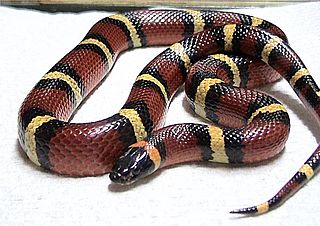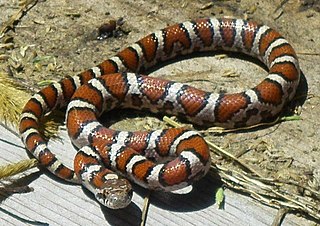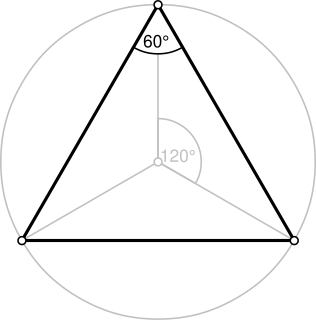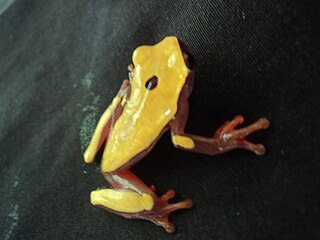This page is based on this
Wikipedia article Text is available under the
CC BY-SA 4.0 license; additional terms may apply.
Images, videos and audio are available under their respective licenses.

Lampropeltis triangulum, commonly known as a milk snake or milksnake, is a species of kingsnake. 24 subspecies are currently recognized. Lampropeltis elapsoides, the scarlet kingsnake, was formerly classified as the subspecies L. t. elapsoides, but is now recognized as a distinct species. The subspecies have strikingly different appearances, and many of them have their own common names. Some authorities suggest that this species could be split into several separate species. They are not venomous or otherwise dangerous to humans.

Kingsnakes are colubrid New World constrictors, members of the genus Lampropeltis, which include milk snakes and four other species. Among these, there are approximately 45 recognized subspecies.

The scarlet kingsnake is a species of kingsnake found in the southeastern and eastern portions of the United States. Like all kingsnakes, they are nonvenomous. They are found in pine flatwoods, hydric hammocks, pine savannas, mesic pine-oak forests, prairies, cultivated fields, and a variety of suburban habitats; it is not unusual for people to find scarlet kingsnakes in their swimming pools, especially during the spring. Until recently, and for much of the 20th century, scarlet kingsnakes were considered a sub-species of milksnakes. However, Pyron & Bubrink demonstrated the phylogenetic distinction of this species and its closer relationship to the mountain kingsnakes of the southwestern United States. These largely fossorial snakes are the smallest of all species within the genus Lampropeltis, usually ranging from 40 to 50 cm at maturity. The maximum recorded length is 68.4 cm (26.9 in). Hatchlings range in size from 8 to 18 cm .

Coral snakes are a large group of elapid snakes that can be subdivided into two distinct groups, Old World coral snakes and New World coral snakes. There are 16 species of Old World coral snake in three genera, and over 65 recognized species of New World coral snakes in three genera. Genetic studies have found that the most basal lineages are Asian, indicating that the group originated in the Old World.

Lampropeltis triangulum campbelli, commonly known as the Pueblan milk snake or Campbell's milk snake, is an egg laying species of nonvenomous colubrid snake. It is commonly bred in captivity and is found in several color variations. When handled, it can discharge a pungent-smelling exudate from its cloaca as a presumed defense mechanism.

Lampropeltis annulata, commonly known as the Mexican milk snake, is a nonvenomous species of milk snake.
Cemophora coccinea copei, commonly known as the northern scarlet snake, is a subspecies of harmless colubrid snake that is found in the southern and eastern United States.

Nelson's milksnake is a subspecies of king snake that is found in Mexico from southern Guanajuato and central Jalisco to the Pacific Coast. It is also found on the narrow plains of northwestern Michoacán and on the Tres Marias Islands. The range of this snake appears to be tied to the proximity of watercourses, including ones utilized for irrigation and agriculture. It is a subspecies of the milksnake, Lampropeltis triangulum. It is similar in size to other king snakes, averaging 42 inches (110 cm) long, and like them, is nonvenomous.

Lampropeltis triangulum sinaloae, commonly known as the Sinaloan milk snake, is an egg laying subspecies of nonvenomous colubrid snake. It is one of the most commonly bred milk snakes in captivity. It is a fairly docile subspecies and will rarely bite. If handled, it will discharge a pungent smelling exudate from the cloaca as a warning. The Sinaloan milk snake inhabits the rocky and semi-arid drylands of southwest Sonora, Sinaloa, and southwest Chihuahua (Mexico).
Kenneth Lee Williams is an American herpetologist and author of books on the subject of snake biology and classification. Williams retired from teaching in Northwestern State University's biology department and received emeritus status in 2001. Williams is considered an authority on the milk snake and the herpetology of the Honduran Cloud Forest.

Cemophora coccinea coccinea, commonly known as the Florida scarlet snake, is the nominotypical subspecies of the scarlet snake. It is a nonvenomous colubrid snake that is endemic to the southeastern United States.

Lampropeltis triangulum hondurensis, commonly known as the Honduran milk snake, is an egg laying species of nonvenomous colubrid snake. It is one of the more commonly bred milk snakes in captivity and is one of the larger milk snakes, reaching a length of 5 feet.

Lampropeltis triangulum triangulum, commonly known as the eastern milk snake or eastern milksnake, is a subspecies of Lampropeltis triangulum. The nonvenomous, colubrid snake is indigenous to eastern and central North America.

Lampropeltis triangulum syspila, commonly known as the red milk snake or red milksnake, is a subspecies of Lampropeltis triangulum. The nonvenomous, colubrid snake is indigenous to the central United States.














